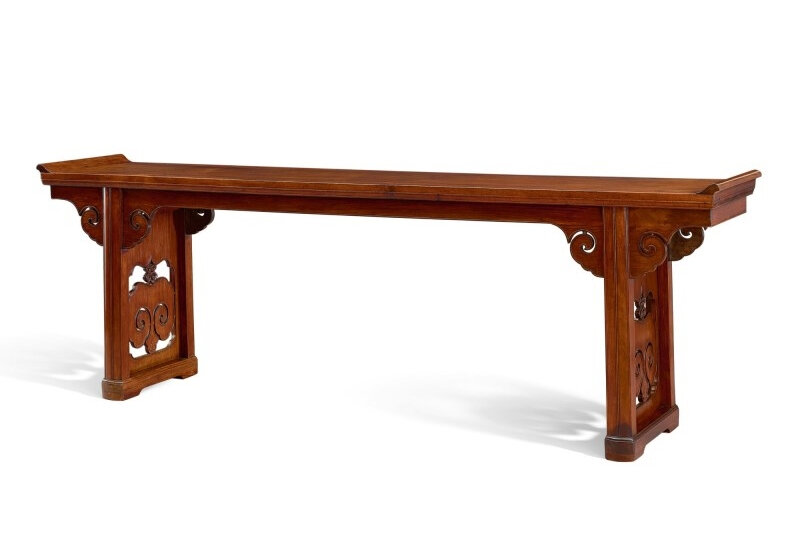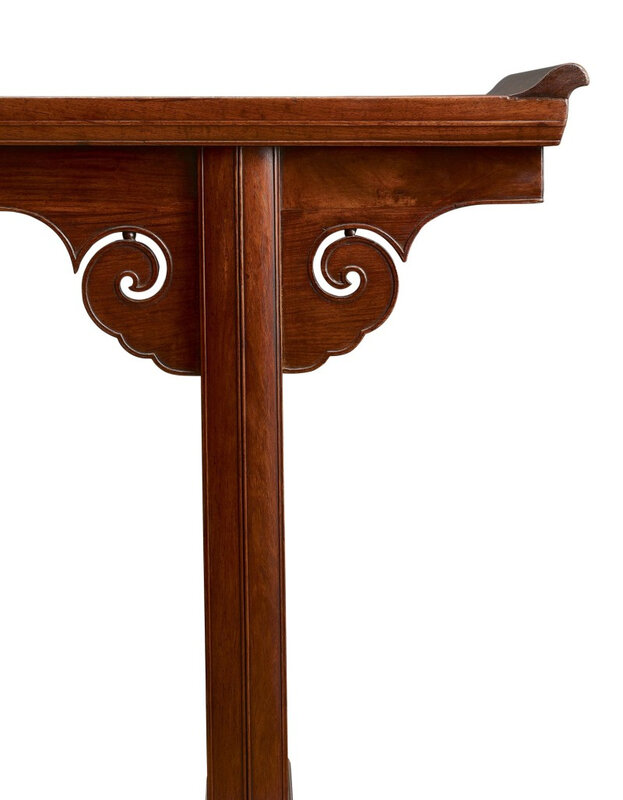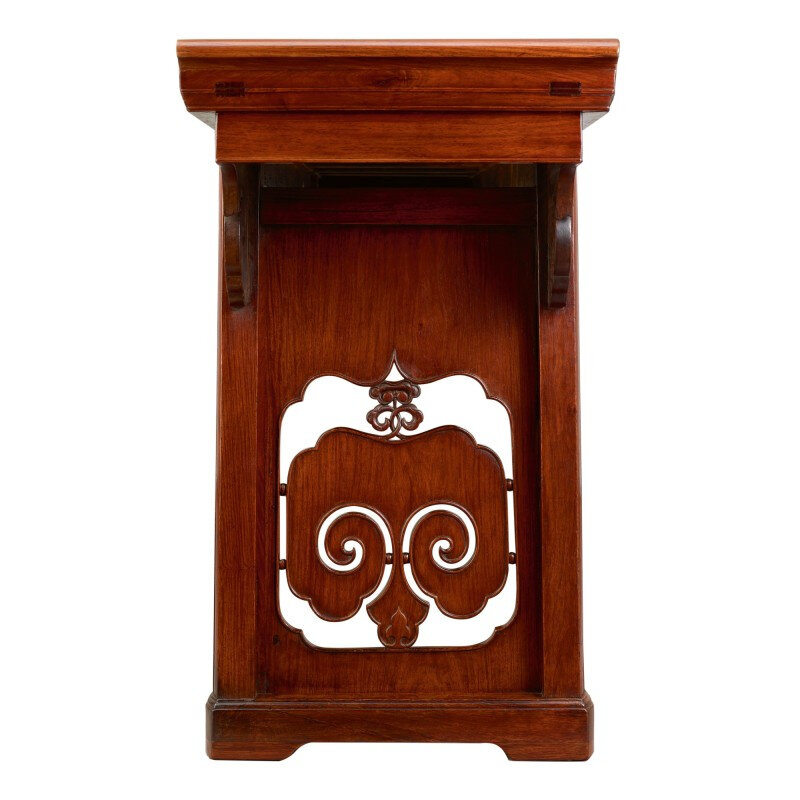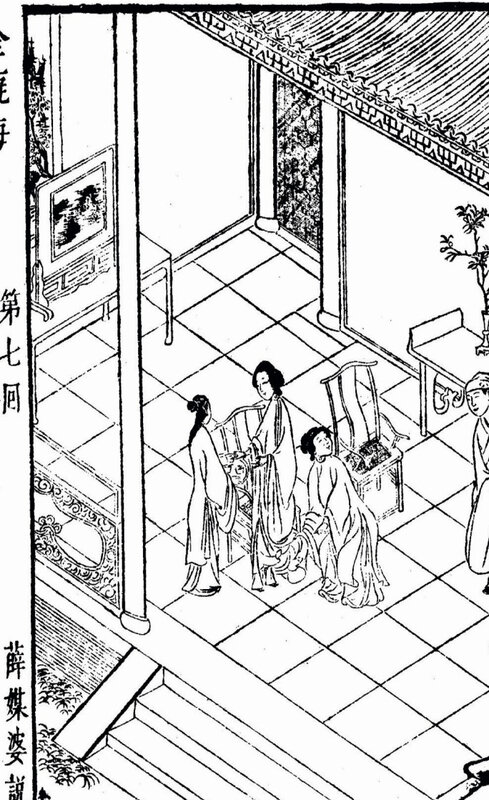Sotheby's. Monochrome II, 9 October 2020, Hong Kong
A huanghuali recessed-leg long table, qiaotouan, Ming dynasty, 17th century




Lot 5. A huanghuali recessed-leg long table, qiaotouan, Ming dynasty, 17th century; 267 by 50 by h. 89 cm, 105 ⅛ by 19 ¾ by h. 35 in. Estimate: 3,500,000 - 4,500,000 HKD. Lot sold 17,115,000 HKD. Courtesy Sotheby's.
the long rectangular single-board floating panel top of well figured wood set with everted ends, surmounting plain beaded aprons and ruyi-form spandrels, raised on thick rectangular section legs enclosing an openwork panel exquisitely carved with a large upright lingzhi motif and tennoned into shoe-type feet.
Provenance : Grace Wu Bruce, Hong Kong, 1987 .
Note: Long and narrow rectangular tables with upturned flanges were popular in wealthy households of the Ming (1368-1644) and Qing dynasties. The present example is however particularly special for delicately carved panels between the legs, and the attractive grain pattern of the huanghuali boards set into the top frame. Placed against the south wall of the reception hall, where important male visitors were greeted, they were used for the display of a few tasteful objects, such as fantastic rocks, seasonal flowers or a treasured antique. Tables of this type with the panels between the legs carved with ruyi heads appear often on contemporary printed books and paintings, such as in the illustration of Chapter 7 of a Chongzhen period edition of Jin Ping Mei [The Plum in the Golden Vase], reproduced in Sarah Handler, 'Side Tables, a Surface for Treasures and the Gods', Chinese Furniture. Selected Articles from Orientations 1984-1999, Hong Kong, 1999, p. 202, pl. 6 (fig. 1). The origins of this type of rectangular table are discussed in ibid., pp 200-201, where the author suggests that the design derives from altar tables made from as early as the Eastern Zhou dynasty (771-256 BC). These early tables with upturned ends are depicted on archaic bronzes from this period, such as a bronze yi illustrated ibid., p. 200. The use of upturned flanges, however, appears to have disappeared prior to the Ming period, when these long rectangular tables gained popularity. The flanges served as a reference to China’s illustrious past, which also increases the table commanding presence within the room.

Illustration In jin Ping Mei [The plum in the golden vase, or The golden lotus], Ming dynasty, Chongzhen period edition, chapter 7.
A table of similar proportions from the collection of E. Boltze, is illustrated in Gustav Ecke, Chinese Domestic Furniture, Rutland, 1962, pl. 65. See also a much larger demountable table attributed to the Ming dynasty, with a similar ruyi-head pattern, in the Palace Museum, Beijing, illustrated in The Complete Collection of Treasures of the Palace Museum. Furniture of the Ming and Qing Dynasties (I), Hong Kong, 2002, pl. 124.

/https%3A%2F%2Fprofilepics.canalblog.com%2Fprofilepics%2F1%2F0%2F100183.jpg)
/https%3A%2F%2Fstorage.canalblog.com%2F03%2F02%2F119589%2F96711876_o.jpg)
/https%3A%2F%2Fstorage.canalblog.com%2F11%2F31%2F119589%2F94773502_o.jpg)
/https%3A%2F%2Fstorage.canalblog.com%2F20%2F83%2F119589%2F94772815_o.jpg)
/https%3A%2F%2Fstorage.canalblog.com%2F26%2F72%2F119589%2F75604929_o.jpg)
/https%3A%2F%2Fstorage.canalblog.com%2F59%2F60%2F119589%2F26458628_o.jpg)


/http%3A%2F%2Fstorage.canalblog.com%2F32%2F99%2F119589%2F129836631_o.jpg)
/http%3A%2F%2Fstorage.canalblog.com%2F46%2F82%2F119589%2F129704536_o.jpg)
/http%3A%2F%2Fstorage.canalblog.com%2F49%2F48%2F119589%2F129680938_o.jpg)
/http%3A%2F%2Fstorage.canalblog.com%2F64%2F83%2F119589%2F129635530_o.jpg)